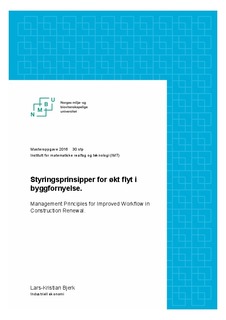| dc.contributor.advisor | Bjørnfot, Anders | |
| dc.contributor.author | Bjerk, Lars-Kristian | |
| dc.date.accessioned | 2016-08-31T08:48:30Z | |
| dc.date.available | 2016-08-31T08:48:30Z | |
| dc.date.issued | 2016-08-31 | |
| dc.identifier.uri | http://hdl.handle.net/11250/2403029 | |
| dc.description.abstract | I følge Bygganalyse (2015) står byggfornyelse for 30% av omsetningen på 410 milliarder kroner i bygg- og anleggsbransjen. Bransjen bærer preg av store tids- og budsjettsprekker og trenger verktøy for å sikre en bedre flyt i prosjektene. Uten økt flyt i prosjektene vil bransjen fortsette å henge etter produksjonsindustrien. Byggfornyelse ønsker å optimalisere prosessen, men foreløpig er det ingen som har klart dette.
Målet med oppgaven er å finne ut: ”Hvordan kan den daglige arbeidsflyten bli styrt i byggfornyelseprosjekter?”. Basert på målet ble fire grunnleggende forskningsspørsmål utarbeidet: (1) Hvordan defineres ”flyt” i byggeprosjekter? (2) Hvordan ivaretar man ”flyt” i byggeprosjekter? (3) Hvilke særpreg har byggfornyelsesprosjekter som gjør flyten annerledes enn for nybyggprosjekter? (4) Hvilke styringsprinsipper passer spesielt godt til byggfornyelsesprosjekter for å gi økt flyt og fremdrift i produksjonsfasen?
I arbeidet med å svare på problemstillingen er det tatt utgangspunkt i teori. Teorien innenfor flyt, styringsprinsipper og særpreg for byggfornyelse var mangelfull. Den var noe bedre for den generelle byggebransjen, men det var ved hjelp av empiri hullene i teorien ble tettet. Deretter ble det analysert hvilke styringsprinsipper som egner seg spesielt godt for byggfornyelse.
Under arbeidene med resultatene viste det seg at majoriteten av byggfornyelsesprosjekter lider av høy uforutsigbarhet og kompleksitet, som gjør det vanskelig for de som leder prosjektene, samt prosjekterende, å planlegge de ulike prosessene og arbeidene som skal utføres.
Analysen viser at styringsprinsippene fra teorien er lite anvendelige i byggfornyelse, men multiskilling og transparency er prinsipper som bør brukes i større grad i denne type byggeprosjekter. Dette vil kunne øke flyten og redusere kompleksiteten og uforutsigbarheten i mange av prosjektene.
Konklusjonen viser at byggfornyelse har stort potensiale for økt flyt og at det må forskes mer for å finne gode styringsprinsipp. Dette for å kunne håndtere uforutsigbarheten og kompleksiteten hvor byggfornyelse har sitt særpreg. Det som gir størst effekt for økt flyt er å ha prosjekter med en god sammensetning av multiskilling og transparency for å redusere kompleksiteten og uforutsigbarheten. | nb_NO |
| dc.description.abstract | According to Bygganalyse (2015) the construction renewal represents 30% of total turnover (410 billions NOK) in construction industry. The construction sector is characterized by lack of both time and funding, and is therefore in need for better managing principles to improve the overall flow of projects. The construction sector is currently lagging behind the production industry, and without optimization of the overall workflow it will continue to do so. Although the renewal sector realizes its need optimizing, there are no current solutions to the problem
The aim of this thesis is to determine “how the daily workflow in construction renewal projects can me managed?”. Four research questions were defined: (1) How is “workflow” defined in construction projects? (2) How can “workflow” be maintained in construction projects? (3) What makes the “workflow” in construction renewal unique compared to new construction? (4) What form of management principles is most suitable to increase both the workflow and progress in the production phase of renewal projects?
To answer the research questions, this thesis has based its research on theoretical principles. Because the construction sector lacks theoretical knowledge about workflow and management principles, the knowledge gaps were filled in with empirical knowledge from the general construction sector. This theoretical background was then supplemented with a thorough analysis of management principles suitable for construction renewal projects.
During the course of this work, it was found that the majority of renewal projects end up being highly unpredictable and complex. This makes both planning and management of the projects tedious and difficult.
The analysis points out that the theoretical management principles in the general construction section are unsuitable for renewal projects, and that multiskilling and transparency are principles that should be central to renewal projects. These principles can help increase the predictability and decrease the complexity of the projects.
In conclusion, this thesis shows that the construction renewal sector has great potential for improvement in workflow, and that there is a need to further determine good management principles that can be applied specifically to this sector. Currently, the most efficient management form for this type of project should incorporate both multiskilling and transparency, and in this way reduce both the complexity and unpredictability of renewal projects. | nb_NO |
| dc.language.iso | nob | nb_NO |
| dc.publisher | Norwegian University of Life Sciences, Ås | |
| dc.subject | flyt-byggfornyelse-styringsprinsipper-særpreg-transparency-multiskilling-kompleksitet-uforutisgbarhet | nb_NO |
| dc.subject | workflow-construction renewal-management principles-transparency-multiskilling-complexity-unpredictability | nb_NO |
| dc.title | Styringsprinsipper for økt flyt i byggfornyelse | nb_NO |
| dc.title.alternative | Management Principles for Improved Workflow in Construction Renewal. | nb_NO |
| dc.type | Master thesis | nb_NO |
| dc.subject.nsi | VDP::Technology: 500::Building technology: 530::Architecture and building technology: 531 | nb_NO |
| dc.subject.nsi | VDP::Technology: 500::Building technology: 530::Building, construction and transport technology: 532 | nb_NO |
| dc.subject.nsi | VDP::Technology: 500::Building technology: 530::Construction technology: 533 | nb_NO |
| dc.source.pagenumber | 98 | nb_NO |
| dc.description.localcode | M-IØ | nb_NO |
